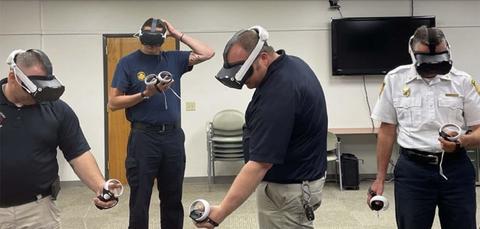Immersive HazMat Virtual Reality Training
HazVR Redefines Safety Preparedness for First Responders
Every emergency call received by a fire department could mean life or death. This reality is further amplified for firefighters who possess specialized expertise in handling hazardous materials, commonly referred to as HazMat. Consider a scenario where a HazMat team is called to investigate a report of gas odor in a home. The team conducts an air monitoring check but finds no trace of gas. Just because they do not detect noxious gasses at first inspection, does that mean they can declare the situation safe? Not necessarily. The invisible danger of some gasses, which can be heavier than air or take a long time to detect, could be lurking low to the floor -- a factor that even experienced HazMat workers might miss.
Given this risk, there's an evident need for thorough HazMat training. One tool designed to address this is HazVR, developed by Jason Jerald and his team at NextGen Interactions, with an aim to change the approach towards HazMat training. Developed under the Public Safety Innovation Accelerator Program (PSIAP) Follow-on Funding for Technical and Business Assistance (TABA) and Demonstration Projects award, HazVR offers a virtual, live-action platform designed for HazMat instructors and students to practice air monitoring, simulating real incident sites. Its simulations are designed to give realistic meter responses and visualize typically invisible gasses. Early testing of HazVR has shown it can provide HazMat workers with accelerated experience accumulation, aiming to increase preparedness and reduce risks.

HazMat training is a non-negotiable necessity for fire departments and public safety agencies. The safety of first responders and the communities they protect hinges on their ability to detect and neutralize hazardous substances.
Traditional HazMat training typically begins in the classroom, where trainees learn the theory behind hazardous materials such as their classifications and handling techniques. After classroom instruction, trainees move onto hands-on training, applying their theoretical knowledge in controlled environments simulating real-world scenarios. To a less frequent degree, trainees participate in full-scale exercises that could include simulations that offer more realistic conditions in a safe, controlled manner.
While generally effective, these traditional training methods are not without their limitations and challenges. Firstly, these exercises are resource intensive. They require physical resources, suitable locations, and significant time commitments from both instructors and trainees. It is also often impractical to repeat these exercises multiple times due to resource constraints. Classroom exercises may lack the immersive quality of real scenarios, potentially leaving trainees underprepared for the unpredictability of actual HazMat incidents.

The application of virtual reality (VR) technology to HazMat training has the potential to have a profound impact on these pain points of traditional training. VR creates a safe, cost-effective, and immersive training environment where exercises can be repeated as needed. Performances can be precisely tracked and evaluated, and a wide array of scenarios can be simulated. For example, in traditional HazMat training, certain details, like visualizing where a gas leak occurred, are simply not possible to demonstrate. HazVR includes a feature that visualizes elements typically invisible in traditional HazMat training, enhancing realism and understanding. It also supports after-action reviews and tracks performance over time, reducing operational risks and offering an alternative to potentially hazardous training methods.
To validate the effectiveness of their virtual HazMat training, NextGen Interactions partnered with the Raleigh Fire Department as a part of their grant award. They integrated feedback from over 100 first responder stakeholders to fine-tune HazVR, focusing on specific learning objectives such as detecting readings, identifying gasses, and predicting gas behavior. Overall, their work evolved out of lessons learned from NextGen’s work under their PSIAP User Interface (UI) award in 2018 and aligns with the Public Safety Communications Research (PSCR) Division’s User Interface/User Experience (UIUX) program goal of improving UI technology capabilities for public safety through VR systems.
In summary, HazVR has been designed with the potential to significantly change HazMat training, utilizing VR technology. This initiative, supported by PSCR funding and feedback, has allowed NextGen Interactions to focus on impactful use cases with real-world implications. By not only mirroring traditional training methods but improving upon them, HazVR enables improved operational processes, rapid simulation, actionable metrics, better training transfer, and a more comprehensive context of dangerous incidents, all of which have the potential to lead to more lives saved.

